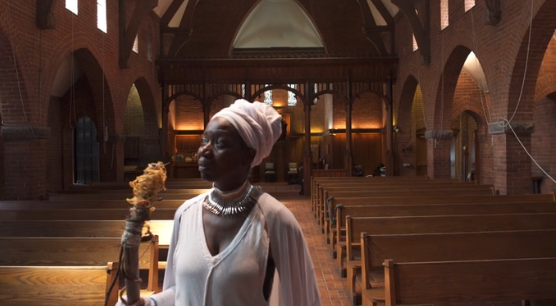
Camille Turner, a master’s and PhD graduate of York University’s Environmental Studies program, received the Toronto Biennial’s Artist Prize for her contribution to the 2022 Toronto Biennial of Art exhibit, the second chapter of a two-part biennial – “What Water Knows, the Land Remembers.”
Open to the public and running until June 5, Turner is displaying a three-channel video installation titled Nave, reflecting on Canada’s underknown historical involvement with the trans-Atlantic slave trade.

“The process of creating Nave was an intuitive one,” says Turner. “What I was thinking through when creating this work was how do you remember these people who were in these ships? And we are talking about almost 6,000 people carried by 19 ships who were suffocating in their holds. If you look in the archive you see the numbers but not who they are. These were adults, children, neighbours, family and friends ripped from homelands and wiped out of human history.”
Nave consists of three intertwined scenes. The immersive multimedia installation explores the link between the nave of a church, a tomb, and the hold of a ship, which Turner calls “the womb of the world.” Revisiting the ship’s hold and impact of the slave trade on Canadian history, Turner’s video features an ancestor from the Age of Awakening – an afro-futurist time-traveller played by the artist herself who visits a church in the Age of Silence in today’s time to perform a ritual pouring libations to honour ancestors who endured the Middle Passage. Another character, an ancestor from the sea, is a reminder of the African diaspora, symbolizing the strength and resilience of ancestors who crossed the water on slave ships. A church, in and out of view, serves as a constant reminder of Canadian history, Black histories, the legacy of the slave trade, and the ideological beliefs at play therein.

“For me, the focus was the people that were in the hold and what is a fitting memorial to honour them and bring them into memory and the piece is a lamentation and a ritual for remembering. It is the past, present and future merging.” Turner adds, “the past is still with us, the past haunts the present and it’s important to recognize this and I hope this is something viewers take away from this work.”
Recently, Turner has been unsilencing the entanglement of what is now Canada with transatlantic slavery. Her interventions, installations and public engagements have been presented throughout Canada and internationally. She notes she was surprised to receive the award from the Toronto Biennial who approached Turner to incorporate her work in the exhibit.
At the opening event of the exhibit, Turner expressed, “I am so thrilled to be the recipient of this prize. This artwork is dedicated to ancestors known and unknown and I want to thank my amazing dream team: Editor Chris Wiseman, Cinematographer Esery Mondesir assisted by Andrew Osei, Cody Westman who shot the footage in Newfoundland, performer Emilie Jabouin, makeup artist Kristen Gallacher, and Production Manager Roxanne Fernandes. Many thanks to the Biennial for the opportunity to unfurl this vision.”
While completing her PhD, Turner merged the production and completion of Nave with her final dissertation at York University. Turner included three projects in her dissertation, Afronautic Research Lab: Newfoundland, Sarah and Nave. Telling the story of the Afronautic journey, the project presents artworks resulting from an Afronautic research-creation methodology developed to engage with absences and fissures in the histories of the Canadian settler state.
Turner recognizes Faculty of Environmental and Urban Change Associate Professor Honor Ford-Smith for being instrumental in her journey at York and supporting her vision for the project. She notes that art-based research is important and there would be no other medium to effectively express the information and stories she wanted to share.
“There is a certain thing that art can do that text cannot. The work I do doesn’t necessarily fit the normative way institutions work, so it was instrumental to have her support to make room for what I'm doing and how I'm doing it... It was important to establish that the dissertation is beyond just the text.”

Ford-Smith described Turner as “a stellar example and brilliant student” who did not conform to the conventional tools of assessment and yet made an outstanding contribution to both African Canadian studies, memory studies and research creation.
“Our program allows for unconventional approaches to education, and it was a perfect program for her in many ways,” says Ford-Smith. “She has a gift for being able to communicate across boundaries of all kinds. Her work is groundbreaking because it uncovers silenced knowledge while representing it originally and accessibly. She speaks to people who may not know about this history of the present and who might not want to read it in an academic format. It was important to find a form that could represent the complexity of what Camille uncovered, speak to Black subjects in this country and also move beyond boundaries of race, time and space, to demonstrate how memories of racial violence might inspire dreams of full freedom in the present and future.”
Through storytelling, Turner finds Black ways of knowing that have not yet been recognized and looks beyond conventional archives by using land and place as a method of work.
“Camille is part of a community that challenges Canada’s national narrative by exploring the histories of Blackness here in Canada and unearths Canada’s collusion with African enslavement. Her work applied a complex research methodology. It involved an environmental method of moving across the land and listening for the stories that have had to be silenced for the land to be made what it is. At the same time, she explored colonial archives of the trade in Africans and worked with personal and collective memories while remaining in dialogue with African and Indigenous communities in Canada,” says Ford-Smith.
Ford-Smith worked with Turner as her supervisor throughout her master’s and PhD. Turner’s master’s, Evoking a site of memory: An Afrofuturist Sonic Walk that Maps Historic Toronto's Black Geographies, received the outstanding paper award and she is also nominated for the PhD dissertation prize for her work titled Unsilencing the Past: Staging Black Atlantic Memory in Canada and Beyond. Turner also collaborated with Ford-Smith on her research project Memory, Urban Violence and Performance in Jamaican communities and contributed to the design and facilitation of the research.
Last year, Turner was announced as the first provosts’ postdoctoral Fellow from the Daniels Faculty at the University of Toronto. She is currently working with art-based research towards featuring a solo exhibition at the University of Toronto’s Art Museum deepening her work and ideas that she discovered while completing her dissertation.
“I feel like I am just scratching the surface and there is much more to do,” says Turner.
To learn more about Nave, visit the Toronto Biennial of Art website.
